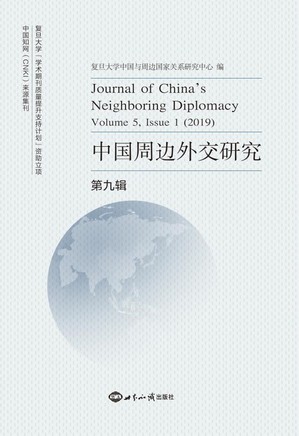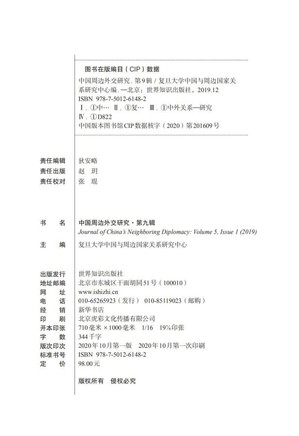Journal of China's Neighboring Diplomacy, Vol. 5 Issue 1 (2019)
|
|
The Title Page of Journal of China's Neighboring Diplomacy, Vol. 5, Issue 1 (2019) | The Copyright Page of Journal of China's Neighboring Diplomacy, Vol. 5,Issue 1 (2019) |
Center for China's Relations with Neighboring Countries of Fudan University (CCRNC-Fudan), ed, Journal of China's Neighboring Diplomacy, Vol. 5, Issue 1, 2019.
Publisher: World Affairs Press (China)
Published in October 2020.
ISBN: 978-7-5012-6148-2
Contents
Preface...... Shi Yuanhua / 1
China's Neighboring Diplomacy in the Past 70 Years
China's Diplomacy toward the U.S. in the Past 70 Years: A Review from the Perspective of China's Diplomacy with Its Neighboring Countries...... Pan Yaling / 11
A Review of 70 Years of China's Diplomacy toward Japan...... Wu Jinan / 31
The History, Reality, and Future of China's Diplomacy toward India...... Guan Peifeng / 52
The Historical Evolution and Future Development of China's Diplomacy with the Region of Central Asia...... Zhang Ning / 74
China's Diplomacy with the Region of West Asia: Process, Achievements, and Options for Future...... Guo Rui / 94
A Review on China's Diplomacy with the Region of South Pacific in the Past 70 Years...... Fei Sheng / 113
Comprehensive Studies on China's Neighboring Diplomacy
On Solving China's Neighboring Issues...... Zhang Yunling / 137
Conception and Practice of China's Neighboring Diplomacy in the Past 40 Years of Reform and Opening-up...... Li Wen and Liu Mingze / 142
Constructing a New Type of International Relations and China's Neighboring Countries Studies...... Xia Liping and Zhong Qi / 159
China's Neighboring Countries Studies Report, Part 3: Young Academics
Reflection and Construction: Exploring Middle-range Theory in China's Neighboring Countries Studies...... Jiang Jianzhong / 177
Discussion on the Value Orientation of China's Neighboring Countries Studies...... Xue Song / 182
Comparison and Integration of China's Neighboring Countries Studies and Diplomatic Theories of East and West...... Cao Wei / 187
Three Interpretations on China's Neighboring Countries Studies and Its Targets...... Zhang Qun / 192
New Subject of China's Neighboring Countries Studies: How to Provide Paradigm for the Region?...... He Jiajie / 197
10 Questions about China's Neighboring Countries Studies from the Perspective of a Learner ...... Zhang Li / 201
Research Topics on China's Neighboring Diplomacy
Assessment and Analysis on the Economic Situation in China's Neighboring Countries...... Zhong Feiteng / 211
BRI and the Internal and External Construction of China's Image...... Ma Lirong / 238
On the Origin of Theory, Contents and Thinking Methods of Coastal Defense in the New Era...... Gao Xinsheng / 248
Reading Recommendation
Preface of Essays on China's Neighboring Countries Studies: Proposing, Presenting and Studying China's Neighboring Countries Studies...... Shi Yuanhua / 269
Reviews on Symposiums
A Review on the 8th Symposium of “China's Neighboring Diplomacy”...... Hu Yangyu / 283
Appendix
Introduction on Center for China's Relations with Neighboring Countries of Fudan University (CCRNC-Fudan)...... 295
Notice Inviting Contributions to the Journal of China's Neighboring Diplomacy...... 297
Standards of Articles and Annotations of the Journal of China's Neighboring Diplomacy...... 299
China’s Diplomacy toward the U.S. in the Past 70 Years: A Review from the Perspective of China’s Diplomacy with Its Neighboring Countries
PAN Yalin
Abstract: In history and reality, the interactions between China and the U.S., the two major civilizations of the world, mostly took place in China’s neighboring countries and regions. Viewed from the perspective of China’s diplomacy with its neighboring countries, the China-U.S. bilateral relations roughly got through three stages: from the systemic confrontations in strategic hostilities, through the “laissez-faire” period derived from their strategic integrations, to the direct games against the background of strategic rivalry. During all this process, continuous innovations have been realized in China’s diplomacy toward the U.S., creating a far?reaching influence on China’s neighboring countries. The strategic idea guiding this diplomacy has been upgraded to the concept of a community with a shared future for mankind, for the purpose of the sustainable development of all humans. The contents of this diplomacy are supported by three columns: politics, economy, and humanity, and is being expanded forward continuously. Whereas the key strategic means of this diplomacy have been transformed to shape a structure that may have the comparative advantages to provide international public goods. Despite of all these changes, U.S. strategic adventurism toward China is on a rise, and the strategic opportunism of China’s neighboring countries also becomes more prevalent. In this sense, China has to meet even higher demands if it wants to achieve a sustainable rise. The core of these demands is to guarantee that China’s neighboring countries act as bridges, not troubles between China and the U.S. particularly, China’s neighboring countries should become confirmers of the China-U.S. structure of comparative advantages for providing public goods, and middlemen of the reconstruction of the China-U.S. value chains. They should act as the demonstration areas of the China-U.S. cooperation for global governance and experimental fields of the mutual learning between China and U.S. civilizations.
Key Words: Neighboring Diplomacy; China-U.S. Relations; Rise of China; A Community with a Shared Future for Mankind
Author:Pan Yaling, Associate Professor at Center for Indian Studies of Yunnan University, Adjunct Researcher at Center for American Studies (CAS) at Fudan University
Official Citation: Pan Yaling, “China’s Diplomacy toward the U.S. in the Past 70 Years: A Review from the Perspective of China’s Diplomacy with Its Neighboring Countries”, Journal of China’s Neighboring Diplomacy, Vol. 5, Issue 1, 2019, pp. 11-30.
A Review of 70 Years of China’s Diplomacy toward Japan
WU Jinan
Abstract: As one of China’s neighboring countries that is separated from China only by a stripe of water of the East China Sea, Japan is the largest developed country of the Asia and one of the most important countries in China’s neighboring areas. In China’s diplomacy with its neighboring countries, its relation with Japan has always been put on the list of top priorities. In 1972, China and Japan normalized their diplomatic relations, opening a new page on the history of their bilateral relations. In the past 47 years, the mutual exchanges between these two countries have surpassed any single period in history, whether in depth or in scope. Both of two countries have obtained substantial benefits from their peaceful coexistence and equal cooperation. However, in pace with the changes of international environment and the shift of relative overall national capacities of these two countries, ups and downs occur in this bilateral relations and twists and turns are inevitably emerging. Therefore, one of the most thorny and important tasks confronting China is how to ensure a healthy development of the China-Japan relations along a stable track through locating common interests and avoiding unnecessary harms, and through a joint effort to follow the trends of the world.
Key Words: China; China’s Diplomacy toward Japan; 70 Years
Author: Wu Jinan, President of Shanghai Association for Japanese Studies, Professor and Vice Director at Advisory Committee, Shanghai Institutes for International Studies (SIIS)
Official Citation: Wu Jinan, “A Review of 70 Years of China’s Diplomacy toward Japan”, Journal of China’s Neighboring Diplomacy, Vol. 5, Issue 1, 2019, pp. 31-51.
The History, Reality, and Future of China’s Diplomacy toward India
GUAN Peifeng
Abstract: Since the establishment of normal diplomatic relation between China and India, the whole development of this relation can be divided into 5 stages in accordance with change of time and important events of “watershed” nature. In the past 70 years and based on general neighboring friendship, China’s diplomacy toward the India has been transformed from pure rhetoric to actual activities, from passive response to initiative measures, and from a focus on politics to simultaneous efforts in multiple fields. Since the 18th national congress of the Chinese Communist Party, China’s relations with the India has been led by the neighboring diplomacy’s guiding principle of “amity, sincerity, mutual benefit, and inclusiveness”, and pushed forward by the big power diplomacy’s concepts of “coordination” and “cooperation”. In this way, the India’s strategic importance within China’s neighboring diplomacy and overall diplomacy has gradually been uplifted, and the contents of this set of bilateral relations have been amplified continuously. Generally, a trend of steady improvement has been maintained on the China-India relations. On the other hand, China’s diplomacy toward the India is still confronted with many challenges that are brought by a diversity of factors in history and reality. China must keep its calmness in its strategic planning and make its decision-making based on a precise “big picture”, so as to handle all the problems and challenges occurring in the ChinaIndia relations. China shall take an effort to promote its strategic partnership with the India.
Key Words: Division and Features; New Concept; New Position; New Content; Challenge and Countermeasure
Author: Guan Peifeng, Professor and Ph.D. Tutor at China Institute of Boundary and Ocean Studies, Wuhan University
Official Citation: Guan Peifeng, “The History, Reality, and Future of China’s Diplomacy toward India”, Journal of China’s Neighboring Diplomacy, Vol. 5, Issue 1, 2019, pp. 52-73.
The Historical Evolution and Future Development of China’s Diplomacy with the Region of Central Asia
ZHANG Ning
Abstract: The development of China’s Central Asia policy can be divided into several ten-year stages. During the first stage, the main task of this diplomacy was to establish formal diplomatic relations and resolve problems left by the history (particularly those related to demarcation of border and frontier stability). During the second stage, bilateral and multilateral cooperation (especially the exchanges promoted by the Shanghai Cooperation Organization) became more and more substantialized and enriched. The third stage began with the “Belt and Road Initiative”. During this stage, the five countries of Central Asia were all uplifted as China’s “strategic partnerships”. And cooperation in different fields has been upgraded to higher levels. A review over the whole development of China’s relations with these Central Asian countries reveals that China’s bilateral cooperation with them have been continuously pushed forward, with the scope of cooperation expanded, the levels uplifted, the contents enriched, and the scale enlarged. The mutual trusts and friendships have been strengthened day by day. The diplomatic practice of the past years indicates that, despite of some problems, China’s Central Asia policy is generally pragmatic, effective, and successful in achieving China’s diplomatic objectives and fulfilling its planned missions. The guiding idea and grand strategy defined by the 19th national congress of CCP reveals that Central Asian countries will continue to occupy an important position in China’s diplomacy in the future. Also, the cooperation on “BRI” will maintain its position as the top priority.
Key Words: China; China’s Diplomacy with Central Asia; BRI
Author: Zhang Ning, Professor at Institute of Russian, Eastern European and Central Asian Studies, CASS.
Official Citation: Zhang Ning, “The Historical Evolution and Future Development of China’s Diplomacy with the Region of Central Asia”, Journal of China’s Neighboring Diplomacy, Vol. 5, Issue 1, 2019, pp. 74-93.
China’s Diplomacy with the Region of West Asia: Process, Achievements, and Options for Future
GUO Rui
Abstract: The beginning of China’s reform and opening-up may be regarded as a “watershed” point that can divide the process of China’s diplomacy with the West Asia in the past 70 years. Before this “watershed” point, the mainstream of this diplomacy had been the “diplomacy for politics”, whereas ever since this point, it has developed into “all-directional diplomacy”, which has continuously strengthened the interdependency between China and the West Asia. In this sense, this diplomacy has become a new point of growth and excellence in both China’s neighboring diplomacy and its overall diplomacy. Since the 18th national congress of CCP, it has been uplifted to a new stage, led by the effort to build a community with a shared future for China and Arab countries and based on joint construction for the “Belt and Road Initiative”. In future, the traditional foundation of the China-Arab friendship should be consolidated and deepened, while the principle of “Consultation Contribution and Shared Benefits” should be put into effect, so as to develop a new-type of international relations that is focused on “win-win” cooperation and to promote the regional peace process actively and pragmatically. Also, an effort should be taken to establish a long-term mechanism for exchanges and cooperation between think tanks of both sides.
Key Words: China; China’s Diplomacy with West Asia; Process; Achievements; Decision-making in the Future
Author: Guo Rui, Professor, Director and Ph.D. Tutor at School of Public Administration, Jilin University, Vice secretary at Institute of Northeast Asian Studies, Chinese Association of Asia-Pacific Studies, Vice President at Institute of Jilin Province Tumen River International Cooperation.
Official Citation: Guo Rui, “China's Diplomacy with the Region of West Asia: Process, Achievements, and Options for Future”, Journal of China’s Neighboring Diplomacy, Vol. 5, Issue 1, 2019, pp. 94-112.
A Review on China’s Diplomacy with the Region of South Pacific in the Past 70 Years
FEI Sheng
Abstract: Although diplomacy with the South Pacific is a relatively weak link in China’s neighboring diplomacy, the status of this region has been continuously uplifted in China’s considerations of overall diplomacy work ever since the groundbreaking establishment of China’s diplomatic relations in this region in 1972. Particularly, tremendous progress has been made in both the depth and the scope of China’s diplomacy with this region, and a high level of institutionalization has been achieved in this field, ever since the 18th national congress of CCP. The historical change of this diplomacy is an outcome resulting from the convergence of a series of factors, including: the evolution of international and regional situations, the foreign policy adjustments of major South Pacific countries, and the more active involvements of China since its all-round rise. Based on bilateral and multilateral economic and trade cooperation, China’s diplomacy with South Pacific countries is focused on uplifting its strategic cooperative partnerships with Australia and New Zealand, and highlighted by a strengthening of its all-directional cooperation and exchanges with island countries of this region. In this way, China is achieving its objective of maintaining long-term stability on the situations of this region and establishing new pivoting points in the fronts of China’s diplomacy. This region will become a new arena to test the effectiveness of China’s diplomacy in future.
Key Words: China; South Pacific; 70 Years; China’s Diplomacy with South Pacific Countries
Author: Fei Sheng, Associate Professor and Ph.D. Tutor at Department of History, Sun Yat-Sen University, Researcher at Center for Oceania Studies, Sun YatSen University
Official Citation: Fei Sheng, “A Review on China's Diplomacy with the Region of South Pacific in the Past 70 Years”, Journal of China’s Neighboring Diplomacy, Vol. 5, Issue 1, 2019, pp. 113-133.
Assessment and Analysis on the Economic Situation in China’s Neighboring Countries
ZHONG Feiteng
Abstract: Neighboring diplomacy is an important part of China’s diplomatic strategy. The main purpose of studying economy of neighboring countries is to serve the interest of China’s diplomacy and national development. In 2008, China’s economy exceeded 28 neighboring countries’ economy combined, whereas in 1992 and early 21st century, China’s economy only amounted to 10% and 20% respectively of neighboring countries’ economy. China had accelerated its economic development from 2003-2015. From 2016-2023, the rise of China’s economy has slowed down and stabilized, indicating that the economic relations between China and its neighboring countries are moving toward the next step. According to the World Bank and IMF, the 2019 global economic growth will drop 0.3% compared to that of 2018, while East Asia, the Pacific and South Asia are still the regions with the fastest growth rate, which in 2019 is expected to be 6.0% and 7.1% respectively. Global trade growth in 2019 will be significantly weaker than in 2017 and 2018, but it is still a rather good year since the financial crisis. The export capacity of developed economies will decline, while the decline in import growth in emerging markets will show a different trend. As the developed economies occupy an absolute share of world exports, the decline in exports from developed countries will lead to a significant decline in world trade growth. In 2018, China’s trade volume with 28 neighboring countries was 1.4 trillion US dollars, accounting for 30.7% of China’s global trade and 59.7% of Asian trade. In 2018, China’s foreign trade pattern was basically stable, and its economic and trade relations with neighboring countries tended to be balanced, and there was no “decoupling” from developed countries. The trade share between China and the surrounding areas has increased slightly, which at least means that China’s trade layout is broader and more dependent on the world economic development. China has surpassed the United States as the largest export market for neighboring economies. As far as the focus of China’s economic and trade relations is concerned, the China-U.S. framework remains the main analytical framework for China’s neighboring economies, but the economic situation around China is diversified. Countries in various sub-regions have their own important export markets. It is not possible for China or the United States plus a large regional country to determine its model. In 2018, the impact of the China-U.S. trade war has become increasingly apparent. Under the current 10% tariff, most institutions believe that Vietnam, Malaysia, and the Philippines are the biggest beneficiaries, but if the tariff is raised to 25%, then in addition to Japan, the loss of East Asia will be the most serious in the world.
Key Words: Neighboring Economy; Economic Growth; Trade Pattern; China-U.S. Trade Friction; Trade Substitution; Production TransferFunding This article is a phased outcome of the National Social Science Fund’s major project “Construction of the Northeast Asian Community with Shared Future: China’s Leadership and Action” (Project No. 18ZDA129).
Author: Zhong Feiteng, Director and Professor at Department of Great Power Relations Studies of National Institute of International Strategy, CASS.
Official Citation: Zhong Feiteng, “Assessment and Analysis on the Economic Situation in China’s Neighboring Countries”, Journal of China’s Neighboring Diplomacy, Vol. 5, Issue 1, 2019, pp. 211-237.
BRI and the Internal and External Construction of China’s Image
MA Lirong
Abstract: In the five years since the proposal of the “Belt and Road Initiative” (BRI), the reputation of China’s national image has risen steadily. However, BRI has been constantly slandered by the United States and other Western powers, leading to the internal and external forces that shape China’s image playing an increasingly fierce game. The construction of China’s national image is thus facing serious challenges, but it is an indisputable fact that China’s national image is shaped by the outside world’s perception of the BRI. In the future, along with the intensive cultivation of the BRI, China should lay a solid foundation in neighboring countries so as to strengthen the construction of China’s “civilized image”, “party image” and “academic image”. This is to further enhance the capacity of self-shaping, connotation construction and soft power of China, facilitating BRI to be stable and far-reaching.
Key Words: BRI; China’s National Image; China’s Soft Power
Author: Ma Lirong, Director of Institute of Silk Road Strategy Studies of Shanghai International Studies University, Director at Center for Islamic Cooperation Organization Studies, Ministry of Education, Chief editor of Journal of New Silk Roadology.
Official Citation: Ma Lirong, “BRI and the Internal and External Construction of China's Image”, Journal of China’s Neighboring Diplomacy, Vol. 5, Issue 1, 2019, pp. 238-247.
On the Origin of Theory, Contents and Thinking Methods of Coastal Defense in the New Era
GAO Xinsheng
Abstract: Due to the rapid social development, the conception of coastal defense in the new era has a profound theoretical origin. The coastal defense conception in the New Era is rich in content, comprehensive in system, and profound in thought. The Central Committee of the Party with President Xi Jinping as the core has scientifically judged the situation at the strategic level of national security and overall situation, clarified the guiding ideology of coastal defense work, and established the development goals. China puts much emphasis on reforming institutional mechanisms, improving ways of making efforts, clarifying the path for goal achievements through thinking in a variety of ways. China safeguards national sovereignty, security, and maritime rights and interests resolutely, striving to build a strong and stable modern coastal defense so as to provide vital guarantees for realizing the Chinese dream of the great rejuvenation of the Chinese nation.
Key Words: Coastal Defense; Conception; New Era; Strategy Funding
Author: Gao Xinsheng, Associate Professor at PLA Army Academy of Artillery and Air Defense.
Official Citation: Ma Lirong, “BRI and the Internal and External Construction of China's Image”, Journal of China’s Neighboring Diplomacy, Vol. 5, Issue 1, 2019, pp. 248-265.








